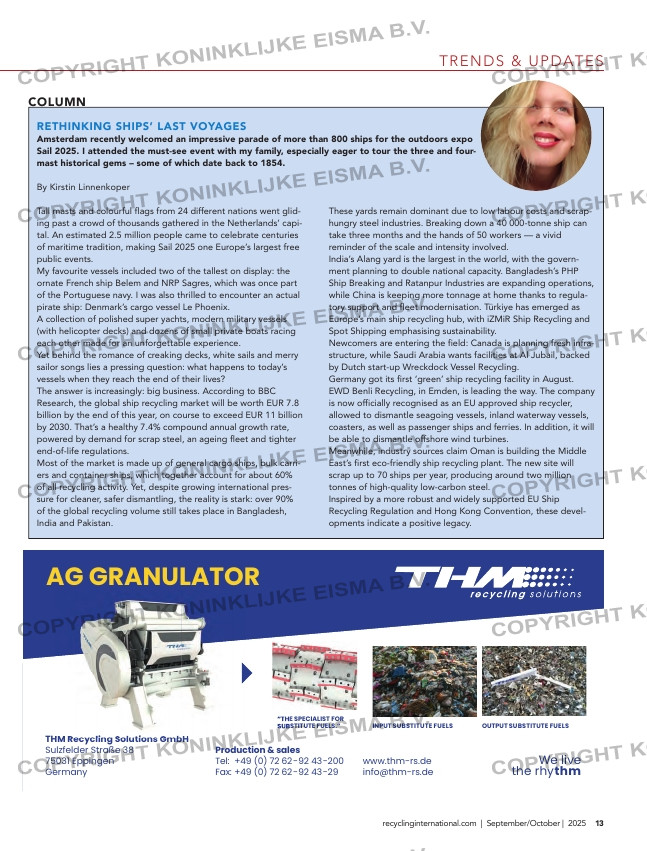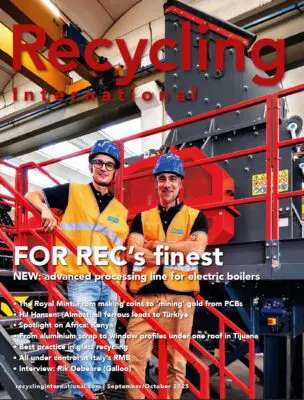Page 13 from: Recycling International September/October 2025

TRENDS & UPDATES
13recyclinginternational.com | September/October | 2025
UK TACKLES ILLEGAL TYRE EXPORTS TO INDIA
British regulators are introducing enhanced checks on the export of tyres after media reports
that millions were being incinerated in India instead of being recycled.
The Environment Agency (EA) concedes it is ‘highly likely’ that a proportion of exported tyres are
being diverted to illegal furnaces. It is the first time it has acknowledged the scale of the problem.
The EA reviewed the sector after revelations by the BBC in March that 70% of tyres exported to India
from the UK and the rest of the world ended up in makeshift industrial plants blighted by explosions,
fires and environmental hazards.
‘We have not been able to verify that exported waste pneumatic tyres are arriving at their intended
destination sites in India,’ the EA says, adding it has an obligation to prohibit exports of waste if
there is a risk that the waste will not be managed in an environmentally responsible way.
Enhanced checks from 1 October will require those exporting tyres to satisfy the EA that waste is
being recovered properly.
The Tyre Recovery Association (TRA) and campaigners gave a lukewarm reaction, wanting the EA to
go further, fearing some loopholes remained to be exploited by criminals. The TRA is ‘very disap-
pointed’ the EA has not adopted the Australian example of banning exports of whole tyres.
Recyclers believe tyres should be exported only after shredding, making it more expensive and diffi-
cult to sell them illicitly in India
The founder of the pressure group Fighting Dirty, Georgia Elliott-Smith, said the plan sounded prom-
ising but appeared to be a system of self-certification paperwork with the threat of inspections ‘not
much different from today’s flawed protocol’.
07.10. – 10.10.2025
Lyon / France
27.10. – 28.10.2025
Bangkok / Thailand
04.11. – 07.11.2025
Rimini / Italy
THM Recycling Solutions GmbH
Sulzfelder Straße 38
75031 Eppingen
Germany
www.thm-rs.de
[email protected]
AG GRANULATOR
INPUT SUBSTITUTE FUELS OUTPUT SUBSTITUTE FUELS
Production & sales
Tel: +49 (0) 72 62-92 43-200
Fax: +49 (0) 72 62-92 43-29
“THE SPECIALIST FOR
SUBSTITUTE FUELS.“
We live
the rhythm
RETHINKING SHIPS’ LAST VOYAGES
Amsterdam recently welcomed an impressive parade of more than 800 ships for the outdoors expo
Sail 2025. I attended the must-see event with my family, especially eager to tour the three and four-
mast historical gems – some of which date back to 1854.
By Kirstin Linnenkoper
Tall masts and colourful flags from 24 different nations went glid-
ing past a crowd of thousands gathered in the Netherlands’ capi-
tal. An estimated 2.5 million people came to celebrate centuries
of maritime tradition, making Sail 2025 one Europe’s largest free
public events.
My favourite vessels included two of the tallest on display: the
ornate French ship Belem and NRP Sagres, which was once part
of the Portuguese navy. I was also thrilled to encounter an actual
pirate ship: Denmark’s cargo vessel Le Phoenix.
A collection of polished super yachts, modern military vessels
(with helicopter decks) and dozens of small private boats racing
each other made for an unforgettable experience.
Yet behind the romance of creaking decks, white sails and merry
sailor songs lies a pressing question: what happens to today’s
vessels when they reach the end of their lives?
The answer is increasingly: big business. According to BBC
Research, the global ship recycling market will be worth EUR 7.8
billion by the end of this year, on course to exceed EUR 11 billion
by 2030. That’s a healthy 7.4% compound annual growth rate,
powered by demand for scrap steel, an ageing fleet and tighter
end-of-life regulations.
Most of the market is made up of general cargo ships, bulk carri-
ers and container ships, which together account for about 60%
of all recycling activity. Yet, despite growing international pres-
sure for cleaner, safer dismantling, the reality is stark: over 90%
of the global recycling volume still takes place in Bangladesh,
India and Pakistan.
These yards remain dominant due to low labour costs and scrap-
hungry steel industries. Breaking down a 40 000-tonne ship can
take three months and the hands of 50 workers — a vivid
reminder of the scale and intensity involved.
India’s Alang yard is the largest in the world, with the govern-
ment planning to double national capacity. Bangladesh’s PHP
Ship Breaking and Ratanpur Industries are expanding operations,
while China is keeping more tonnage at home thanks to regula-
tory support and fleet modernisation. Türkiye has emerged as
Europe’s main ship recycling hub, with iZMiR Ship Recycling and
Spot Shipping emphasising sustainability.
Newcomers are entering the field: Canada is planning fresh infra-
structure, while Saudi Arabia wants facilities at Al Jubail, backed
by Dutch start-up Wreckdock Vessel Recycling.
Germany got its first ‘green’ ship recycling facility in August.
EWD Benli Recycling, in Emden, is leading the way. The company
is now officially recognised as an EU approved ship recycler,
allowed to dismantle seagoing vessels, inland waterway vessels,
coasters, as well as passenger ships and ferries. In addition, it will
be able to dismantle offshore wind turbines.
Meanwhile, industry sources claim Oman is building the Middle
East’s first eco-friendly ship recycling plant. The new site will
scrap up to 70 ships per year, producing around two million
tonnes of high-quality low-carbon steel.
Inspired by a more robust and widely supported EU Ship
Recycling Regulation and Hong Kong Convention, these devel-
opments indicate a positive legacy.
COLUMN
10-11-12-13-14-15_trendsupdates.indd 13 09-09-2025 09:03



